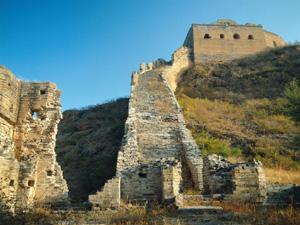| Tools: Save | Print | E-mail | Most Read |
| The Wall, Unplugged |
| Adjust font size: |
Considering that it was constructed for the purpose of keeping foreigners out of
If you've only done the chairlift at Badaling, however, you can hardly count yourself as a Wall veteran. Indeed, speak to any tourist visiting Let's be honest - all three of these sections are intensely marketed to tourists of varying persuasions - and while all of them are fine parts of the Wall to see, on a monument with sections scattered across the country there is certainly a lot more ground to be covered. We may no longer be able to follow in the steps of William Lindesay - the Briton who journeyed the entire length of the Wall on foot in 1987 - but there are still numerous locations within reach of If you want to be able to stay a step ahead of those backpackers who assume they've seen more of
Don't forget that much of the Great Wall in this part of the country climbs near-vertical mountain faces, so if the only exercise you've been doing is thumbing through boxes of DVDs, gird yourself to expend some effort. The Wall sections in most of these locales are rough staircases up mountainsides. The climb, however, is more than worth the effort. If you're making a weekend of it, you'll usually be able to find a local farmer with a room to rent - they're used to tourists coming knocking. In Xifengkou, however, you'll need to go back to Qianxi to find a hotel, and in Jiumenkou and Laolongtou, head for the walled city of The Great Wall at Jiankou Jiankou is hiking Wall, where you'll be clambering over fallen brick and inching your way up steep un-railed mountain faces - take care. The white cliff rock used in its construction makes Jiankou stand out strikingly against the heavily forested hillsides, making it one of the most photogenic Wall sections. You can camp out for the night in one of the towers -but don't forget to take sufficient drinking water with you. The Great Wall at Huanghuacheng Overgrown with sweet yellow flowers in the summer and stretching high above a natural spring lake and crescent-shaped water reservoir, this is a beautifully preserved section of the Wall favored by nature lovers all year round. That being said, the paths are far from pristine - this is 420-year-old masonry - but the climb isn't steep until you get higher up, and in some parts the walk is very pleasant. The Great Wall at Huangyaguan The Huangyaguan Wall in The Great Wall at Xifengkou Characterized by almost obliterated Wall stretches that lie between curiously well-preserved watchtowers, Xifengkou is most famous for a submerged section - depending on reservoir levels, the underwater Wall can be seen as a ghostly silhouette of ancient glories. The Nationalists found this pass as strategically valuable as ever when staging successful resistance attacks here against the Japanese in 1933 - if you look carefully, you can still find bullet holes in the Wall. The Great Wall at Jiumenkou The Jiumenkou Wall near The Great Wall at Laolongtou The Great Wall finally meets the sea at Laolongtou - the head of the Wall. This is a level and fully reconstructed section that extends from the beach all the way back to the walled city of (New York Times April 11, 2007)
|
| Tools: Save | Print | E-mail | Most Read |
 |
| Related Stories |
|
Product Directory China Search |
Country Search Hot Buys |

